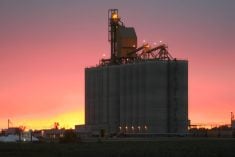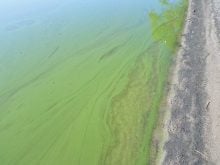NEAR PERFECT TO DISASTROUS
As I write this, we’re well into May and the weather has turned very cold. On the plus side, many areas of Alberta have wrapped up seeding and parts of western Saskatchewan could actually use a nice rain. I’ve actually heard some farmers mutter that they seeded into “nearly perfect” conditions. As you go east, however, it’s another story entirely. I recently travelled from Lumsden, Sask., to Winnipeg and couldn’t believe the water. The Assiniboine River is still rushing and flooding land and homes as of late May. It makes putting together an issue about harvest rather difficult, as many fields are still unworked or only recently seeded (and let’s not even talk about all the ones still under water). Here’s hoping the sun is shining now, and all that water is starting to recede.
Read Also

Cancer agency reclassifies another herbicide ‘probably carcinogenic’
The WHO’s cancer research agency has now put atrazine, a herbicide well known to corn growers, in the same potential-hazard category where the agency put glyphosate.
THE INVESTMENT IN FIELD SCOUTING
However difficult this seeding season has been, eventually what crops are in the ground will pop up, and so begins the all-important monitoring of growing conditions, field staging and pest scouting.
As Jason Casselman writes on page 8, proper crop scouting isn’t a cost or task, it’s an investment and a risk management tool.
While it’s impossible to cover each field in its entirety, accurately scouting and recording weeds, diseases and insects on a representative area of a field will start to build the information needed to track what’s happening in your fields year over year. When in doubt as to the identity of a weed or pest, call in a professional. Take samples with care (plants need to be recognizable by the time they get to an expert) and carry a decent camera with you; cameras on phones rarely produce images of high enough quality to accurately determine crop damage or identify an insect.
Keeping good records is essential, and following through on the cause of damage or a poor stand will save you from making costly errors or mistakes again. With the added pressure of weed resistance, it’s never been more important to map spray “misses” and determine the cause. Was it a sprayer problem, an application rate issue or product mistake, or is there a resistant population blooming? Good field records could help you determine the root cause, as each field’s history should be easy to access. When it comes to resistant biotypes, of course, field history will only indicate a potential problem — plants should be tested to confirm resistance.
Using GPS referencing for field scouting isn’t necessary, but as Casselman notes, it does add a layer of consistency and repeatability that just can’t be had by estimating your location, especially year over year. Finally, and I’m glad he brought this up, linking your in-field observations and mapping with your (preferably GPS-equipped) yield monitor is a great way to tie all the information together and make your commitment of time and energy to crop scouting worth it.
STRIPPER HEADERS AND SAWFLY
You’d never know it by the last few growing seasons, but moisture is usually the limiting factor for crop production on the Prairies. While the advent of zero till and the trend toward somewhat taller stubble has increased soil moisture-holding capacity and snow-trapping ability of many fields, there is another level of tall stubble that many farmers don’t even consider. The stripper header does exactly what it sounds like — it strips off only the heads and sometimes only the kernels and leaves the stubble entirely intact.
There are several benefits to using a stripper header — such as more efficient use of the combine due to very little residue going through the machine — but there are drawbacks, too. Leaving the entire length of stubble standing can leave one nightmare of a residue situation at seeding. That said, farmers are finding major cost-of- production and yield benefits to using the headers. For more, read Garry Ropchan’s account of research in the Peace River region of Alberta on page 26.
Another benefit of leaving tall stubble that isn’t often discussed is the impact it has on pest populations. Specifically, Scott Meers, insect management specialist with Alberta Agriculture and Rural Development, says leaving tall stubble can significantly decrease sawfly populations. “More stubble means more parasitic wasps, which brings down the number of sawfly,” he says. The key is tall stubble that remains through the fall and into the spring, however. If you mow the tall stubble before seeding, it negates the benefits.
Insect predators never cease to amaze me, and this little wasp is no exception. TheBracon cephifemales first paralyze wheat stem sawfly larvae, which is the damaging stage of the pest, then lay their eggs on the larvae. When they hatch, the wee wasps feed on the sawfly larvae, killing them. It’s a brutal but very effective pest control measure. “The wasps are sawfly-killing specialists,” Meers says, adding that the wasp’s first choice for laying her eggs is the sawfly, making them very effective killers.
While wet weather does decrease sawfly populations, Meers says it’s actually because wet weather often delays harvest, leaving stubble intact longer so a second generation of wasps is successful. “It’s less about the sawfly not liking wet weather, and more about the wasps having more habitat to live in,” Meers says. Leaving stubble at full height, such as with a stripper header, would mean wasp populations build even in dry years, further decreasing the number of sawfly.
COMBINES AND LOSS MONITORS
Scott Garvey delves into the dark underbelly of setting combines and combine loss monitors in this issue’s Machinery and Equipment section starting on page 23. OK, so maybe it’s not so dark, but I did learn a thing or two about how loss monitors work and why it’s important to calibrate them. Also, keeping tabs on what the combine is blowing out the back end is always a good idea. For a detailed look at fine tuning your combine’s settings, see page 23.
THE CWB AND THE MONOPOLY
It used to be that I just muttered three letters that sounded like CWB and I’d have phone calls and letters both vilifying and praising the board with such intensity I was nearly always rendered speechless. But now, as the Conservatives settle into their majority government and clearly state the wheat board’s monopoly is on the chopping block, I’m rather surprised by the under-whelming response I’ve received.
Perhaps it’s the timing — it’s seeding season, and a tough one at that — or maybe it’s the inevitability of it all. But for all the bickering, shouting and endless editorials back and forth about the pros and cons of the monopoly, now that it’s on its way out, the masses are relatively silent. Why is that?
I have heard from some of you, yes, and Lee Hart collected some thoughts from farmers in this issue’s Farmer Panel (page 10). Those I have heard from are mostly relieved to see the end in sight, as they’ve been frustrated to see higher prices on which they can’t capitalize, south of the border. Many also hope this will mean the beginning of more processing on the Prairies. But there are also those who fear that once it’s gone, there’s no turning back, and who use the logic that if the Americans don’t like the board, it must be good for Canadian farmers.
Seeing as I don’t grow any wheat, I try and stay out of whether the board should stay or go. Now that it’s going, what do you think will change? Will you seed more wheat and barley now that the board’s gone or is the opposite true? Will the board survive in some capacity? Will flour mills and processing increase on the Prairies? I’d love to hear from you. Email me at [email protected] or write to Box 9800, Winnipeg, Man., R3C 3K7. I’ll try and devote some space in the next issue to your replies.
Lyndsey














